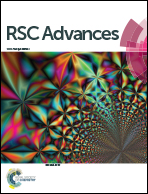Core/shell TiO2–MnO2/MnO2 heterostructure anodes for high-performance lithium-ion batteries†
Abstract
Core/shell TiO2–MnO2/MnO2 heterostructures were synthesized by combining an electrospinning technique with a hydrothermal reaction. To create the starting materials, porous TiO2–carbon nanofibers were first prepared using a simple electrospinning technique followed by calcination. The porous structure in TiO2–carbon nanofibers caused by the partial decomposition of polystyrene is beneficial to the diffusion of KMnO4 from the outer surface into inner fibers to completely react with carbon and produce MnO2 nanosheets. Some MnO2 nanosheets in the TiO2 core connect with other MnO2 nanosheets surrounding the TiO2 core to form core/shell TiO2–MnO2/MnO2, which can enhance the stability of the structure. The large surface area of the resulting materials offers a sufficient electrode–electrolyte interface to promote the charge-transfer reactions, which yields a better rate capability. The porous structure of TiO2–MnO2/MnO2 nanofibers not only facilitates Li-ion access, but also accommodates large volumetric expansion during the charging–discharging processes, resulting in an excellent cycle performance. As an anode, this material delivered a high reversible capacity of 891 mA h g−1 at the first cycle and maintained the capacity of 888 mA h g−1 after 50 cycles at the current density of 0.1 A g−1; it also showed a remarkable rate capability of 2 A g−1 while retaining a capacity of 185 mA h g−1 after 500 cycles. Given their enhanced electrochemical performance, core/shell TiO2–MnO2/MnO2 heterostructure nanofibers are promising anode candidates for lithium-ion batteries.


 Please wait while we load your content...
Please wait while we load your content...